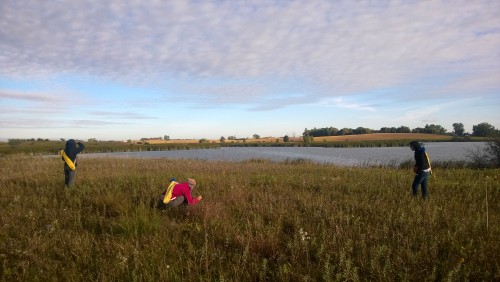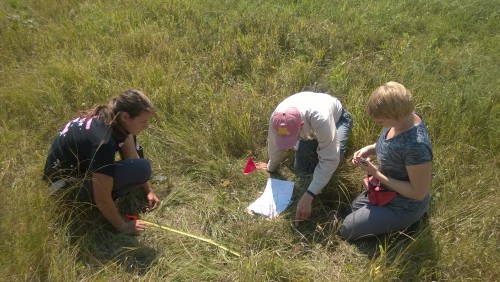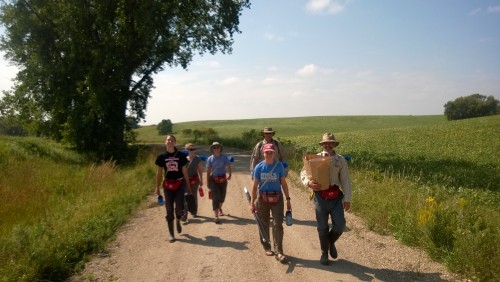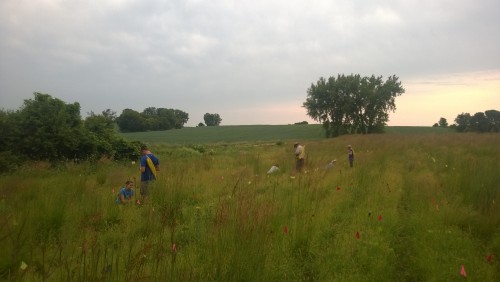|
|
September 28 started as any ordinary fall day would – in the lab at the Chicago Botanic Garden – but if one were to pay attention they would notice slight change from usual. Our backpacks were more full, the lab tasks were taking lower priority, and both Amy and I had brought a full bag of carrots as snacks. At around noon, Stuart arrived at the Garden after an already long day of traveling, informing us that he and Gretel had just arrived and we would be leaving as soon as possible for Minnesota. After a little more time in the lab, we were off in a white pickup truck with a skybox bearing the crest of the CBG. The journey was long, but uneventful besides a stop in the Twin Cities for ice cream. We arrived in Kensington after 11pm and quickly fell asleep in our former summer residence.
The next 4 days proved to be very productive for the group. We finished measuring at Caroline’s and Lydia’s plot, finished seedling refinds, finished all the “can’t find” rechecks in both P1 and P2, and we removed all the flags from P2. We prepped the burn site by mowing the burn breaks and cutting down branches that were in the path. The weather didn’t cooperate so we weren’t able to burn last week but the forecast was hopeful so we planned to try again Monday, October 5th. Amy stayed up in Kensington with Ali and Katherine and together, the three of them finished dissecting all the heads from Q3. I stayed in Northfield for the weekend, and Stuart and Gretel went back to Illinois.
Monday came and Stuart and I headed back up to the farm with hope in our hearts that we would have a successful burn. We got all the supplies ready, including water packs, buckets, giant containers, and most importantly, drip torches. We started the fire at 3pm, worried about the high humidity and lack of sunlight, but we knew we had to try. After an hour of patchy, inconsistent, slow moving fire, we decided to put out the fire and wait for a better day. Though we weren’t able to burn p8, we were able to create a great burn break and get the team experienced with our fire fighting gear.
On Tuesday, Ali, Katherine, and Amy drove the Ranger down to Illinois, while Stuart and I took the train. It had been a long week filled with many victories and only a single defeat. Though the weather won for a day, we know that we’ll be back and ready to burn once more.
While field work continues in good old Kensington, Amy and Danny have moved to their new residence in Evanston to begin work at the Garden. It’s an exciting time filled with new faces such as the many wonderful volunteers who help clean, count, weigh, and do many other things with Echinacea heads. Today, Nina, who goes to the Illinois Math and Science Academy, was in the lab and we were able to discuss what she’ll be doing for the year (more to come later). The shiny metal of the lab was quite a change from the vivid goldenrod and smooth blue aster of the prairie and Jared’s standing desk set up only partially simulates the feeling of standing in a patch big blue stem. All in all, it’s a different environment but a very welcoming one and the Garden itself is absolutely beautiful.
As the title suggests, today was the only day this week that we didn’t harvest. It was also the chilliest by far! With a nice cool 48 degrees to start the day, we went to one of the recruitment plots to do demography and didn’t find a single flowering plant. We tried going to the other plot nearby and realized that it was going to be wet and we didn’t have boots so we pushed it off for later.
 Searching in an Echinacea barren land We then went and did seedling searches for the rest of the morning and got quite a bit done!
 Amy and Katherine find a focal plant After lunch Ali and Katherine practiced driving and Amy and Danny went to another site to look for seedlings. After that we harvested a bunch of Bouteloua curtipendula to put into our one of our most recent experimental plots. Overall it was a productive day with a lot of fun and a large amount of cold wind.
 A gallon of Bouteloua
We started out the day learning about seedling refinds. We aren’t looking for any more new seedlings this year but trying to find plants that were seedlings between 2007 and 2013. It was difficult at first but we all go the hang of it pretty quickly.
 Stuart helps Katherine and Abby with a tricky bunch of seedlings At lunch, we heard Abby and Matt give us previews of talks that they’re going to give during the year. After lunch we went to a new site and it was an adventure and a half! Or at least it was new for most of this summer’s team. First we walked along the road and enjoyed the sunny day. Next, we trekked across a soybean field that looks like it’s going to have a good crop this year but it was really hard for us to get through. Finally we walked through some trees to discover a small paradise hidden between fields. We did demography on and surveyed all the flowering plants that we could find. We found 20 plants this year which, according to Stuart, is a lot less than they’ve seen in previous years. We ended the day with a delicious refrigerated watermelon that was pulled from the garden yesterday.
 Up the road  Across the field  The lush hillside
We started off the day by doing demography rechecks at Landfill and the sites nearby, performing CSI like forensic investigation to determine which flowers were missing and which tags had been misentered the fist time around. We made a to a couple of remnants to harvest heads before lunch and then at lunch we got a final update from Will about his plans for heritability of phenology in the experimental plots. Gina was put in the hot seat, once again, to tell us everything she could about the results of Abby’s and her aphid exclusion experiment.
The afternoon was spent harvesting and though most of the heads in p1 and p2 aren’t ready to be harvested, we have quite a few from the remnants that have been clipped and bagged. We’re excited to try a new sampling technique in the remnants where not only are we taking 5 random heads, we’re also taking the earliest flowering, latest flowering, least isolated, and most isolated heads in order to see if they fit in with the patterns found in the overall population.
Today was Gina and Will’s last day at work and we’re sad to see them go but excited to see what they do with their projects from the summer as well as their own research interests.
This Sunday was, perhaps, the laziest day the Team Echinacea has experienced all summer. The excitement (and sadness) for the day was everyone driving down to Alexandria to drop Ben off so he could take the bus to the airport. He has since safely arrived in Rhode Island, much to our relief. The rest of the day spent laying on the couch, sitting at the table, laying in bed, reading, browsing the web, and a little bit of Echinacea oriented discussion. It got us nice and ready for a productive week to come.
There’s no such thing as an ordinary day during the summer for Team Echinacea but today was particularly exciting because we accomplished many different small (but highly necessary) tasks. We started the day sending 4 people out to do phenology in the remnants, p1, and p2. This took us around 30 minutes because there are now less than 20 flowering heads. Out of a total 4293 flowering heads in the places that we’ve been doing phenology only about 0.4% of the heads are still flowering. During phenology part of the team cut down the sumac and pulled thistle in the ’99 south plot. After that the team split in two and half of us organized g3 (picture tomorrow, it looks great!), and the other half dug up bird’s foot trefoil near p1 on the road. Amy GPS-ed a couple more points that still needed GPS-ing while Abby and Gina continued to tame aphids.
 Amy and Stuart hard at work During the afternoon, Hegg Lake was the place to be with gallium being harvested and data taken on thistles. Will, Ali, and Danny did some top quality film work trying to get a measuring protocol video. We also placed 3 RFID capsules at one of our less stable sites to see if they’ll survive the winter. Stuart not only got the demography protocol good to go for the rest of us, he also made it readable on all devices! Finally, and perhaps just as important as the rest, Erica (Ricky/Eric/Ricardo) got much bigger over the weekend! It’s a great start to what will be a productive week.
 Erica looks about as big as my finger!
Today was an exciting day for Team Echinacea! While most of the day was spent measuring, it was made much more invigorating by the constant threat of rain – which we felt drops of from time to time – and by Ruth’s visit and Stuart’s return. We heard about the many exciting talks that Stuart went to at ESA and discussed how our phenology research is going to both fit in and stand out in a wonderful way. Speaking of large data sets, we’rd almost done measuring p1 and will be moving on to plenty of other fun things soon.
 The team measuring plants in big batch During lunch we learned about how the 1600 gallon septic tank was emptied yesterday and contained 2000 gallons of waste. How that was possible, the world may never know, but here in the Echinacea Project we redefine what’s possible.
 Gretel describes the overfull septic tank as Stuart and Ruth listen
We started the day with phenology in all of the remnants as well as p2. It’s quite apparent that we’re past peak within the remnants and many of the big sites have more flowers that are done than still flowering. It’s an exciting time to be an Echinacea because the styles have shriveled and the achenes will be forming soon.
 An early afternoon meeting We spent the afternoon finishing the crosses between the landfill sires and dams in p1 and then wrapped up with watermelon! Stuart, Danny, and Will had a watermelon seed spitting contest and Stuart’s rapid fire technique left all of us wondering where the seeds had went. In the end Stuart was victorious, spitting it roughly 4-5 meters and impressing us all.
 Roxie is excited about the watermelon!
As we are wont to do in team Echinacea 2015, we started the day with a wonderful bout of phenology. The number of newly discovered plants is really starting to slow down but as we get closer to peak flowering, more and more will become apparent. Speaking of peak flowering, it seems to be almost that time of year for the Echinacea, some sites, like Landfill, are already seeing plenty of heads near the end of their flowering for the summer. Both p1 and p2, having been burned this year, are a little slower on the uptake but they’re starting to gain momentum.
 A “done flowering” Echinacea leads the way for its flowering brethren. Before lunch, Stuart took a group of us out and showed us the proper technique for painting the bracts to identify styles for hand-crosses. We made some paint holsters and feel ready for some compatibility assessment!
|
|














